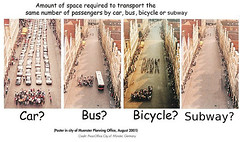Rebalancing urban mobility priorities towards sustainability and the DC example
I have a couple of half written blog entries about this topic, I just don't really have time to finish something these days... But I started writing this entry as a comment in the thread on Washcycle, in response to this particular entry, "The Empire Strikes Back." Washcycle, Greater Greater Washington, and other online media sources have been very good on the topic. I regret that I haven't had the time heretofore to weigh in.
1. Washcycle comments how Mid Atlantic AAA has had to back down from its "war on drivers" position in the face of criticism from members, the national AAA, and other stakeholders. Instead, they have repositioned their argument about "the process" and whether or not there has been adequate study and public involvement.
2. There is no question that DC OP and DDOT can always improve the public process. Sure.
3. But wrt this issue that is somewhat disingenous a position for MA AAA because there has been a public process that has been reasonably decent. What happened is that the public process was designed to prioritize sustainable transportation, not automobility, and so Mid Atlantic AAA isn't happy.
4. The real question is the issue of rebalancing transportational space towards urban priorities rather than suburban mobility paradigms of automobility/autocentricity and the optimal use of infrastructure.

Flickr reworking by Russ Nelson of an original image and concept by the City of Muenster, Germany.
5. The city's urban form was designed at a time when cars didn't exist. The center city was designed very specifically to prioritize walking first and foremost.
It happened that as transit and bicycles were added to the mix, these modalities also worked very well in a form and development pattern that was reasonably dense, and put work destinations pretty close to where people lived, and overlaid neighborhoods and the close by city center with civic amenities and other destinations. (See the webpage "The Automobile Shapes The City: From “Walking Cities” to “Automobile Cities." This idea is based on the paper by Peter Muller, "Transportation and Urban Form: Stages in the Spatial Evolution of the American Metropolis.")

Short blocks, radial avenues that cut across the grid, population density, neighborhood-based amenities, and "jobs-housing balance" typifies Pierre L'Enfant's design and ideas for how DC was supposed to develop. The idea is to create an urban system which works to minimize the need to make special trips, or trips of long distances.
Public policy ought to "demand" that public space be utilized most efficiently and optimally. Therefore, how the network of streets is designed and used, ought to be re-allocated to the most efficient modes.
Walking, transit, and bicycling is the most optimal way to get around in the core of the city especially.
Therefore walking, biking, and transit use on the city's streetspace should be prioritized, not begrudged.
That is going to cause lots of animus on the part of the automobilist.
6. Because most DC residents were not originally urban dwellers, they too tend to be imprinted with what we might call a suburban-centric viewpoint of how mobility works, and the accommodation of cars.
I constantly tell people in the suburbs (where I am working at present) that it isn't any easier to rebalance mobility towards sustainable transportation in the city, that many urban constituencies are just as committed to their automobile and prioritizing parking space as any suburbanite.
The Mid-Atlantic AAA position with regard to the car: first, foremost, and always; regardless of the place, is a perfect example of this.
7. So related to this, the rebalancing, and my unfinished blog entries, is the "Barnes dance" pedestrian prioritized intersection coming to 7th and H Streets NW. That's another example of what the city needs to do at least in the core of the city, making more places more congenial to and supportive of walking, since a majority of work trips in the city are conducted sustainably (walking, transit, bicycling), and in the core of the city, a significant number of nonwork trips are performed sustainably as well.

Pedestrian-prioritized intersection at Yonge and Dundas Streets, Toronto. Toronto Star photo.
8. At the same time, GGW was right to point out a few weeks ago, that the city hasn't adequately planned for surface-based transit prioritization downtown. I wrote about that in "Bus transit prioritization and creating a downtown transitway network."
9. But the best public process in the world isn't going to get automobilists to back down, despite the logic, despite traffic plans, etc. Mid-Atlantic AAA doesn't care about the process. What they care about is prioritizing automobiles, always, all the time, anytime.
10. Plus, they aren't going to accept the urban planning belief that some degree of congestion is a good thing, that it discourages people from driving, and that it is a sign of vibrancy and success, at least in the city. (In the suburbs it's a sign that the mobility system is unbalanced.)
Labels: bicycling, car culture and automobility, civic engagement, progressive urban political agenda, sustainable land use and resource planning, sustainable transportation, transportation planning



0 Comments:
Post a Comment
<< Home